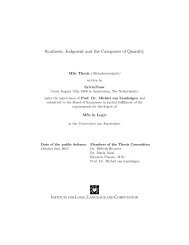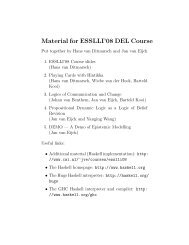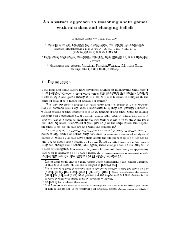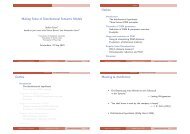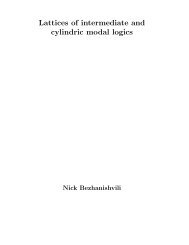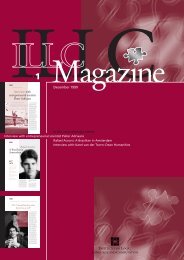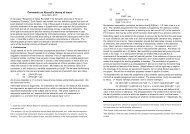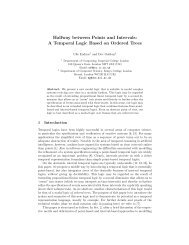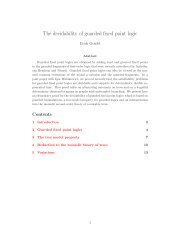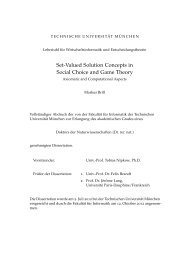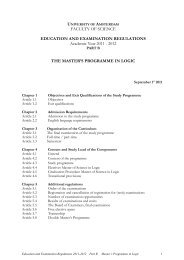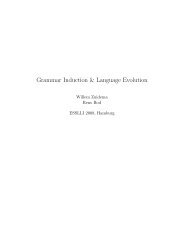De Jongh's characterization of intuitionistic propositional calculus
De Jongh's characterization of intuitionistic propositional calculus
De Jongh's characterization of intuitionistic propositional calculus
You also want an ePaper? Increase the reach of your titles
YUMPU automatically turns print PDFs into web optimized ePapers that Google loves.
<strong>De</strong> Jongh’s <strong>characterization</strong> <strong>of</strong> <strong>intuitionistic</strong><br />
<strong>propositional</strong> <strong>calculus</strong><br />
Nick Bezhanishvili<br />
Abstract<br />
In his PhD thesis [10] Dick de Jongh proved a syntactic <strong>characterization</strong><br />
<strong>of</strong> <strong>intuitionistic</strong> <strong>propositional</strong> <strong>calculus</strong> IPC in terms <strong>of</strong> the Kleene<br />
slash. In this note we give a pro<strong>of</strong> <strong>of</strong> this result using the technique <strong>of</strong> the<br />
universal models.<br />
1 Introduction<br />
The problem <strong>of</strong> a syntactic <strong>characterization</strong> <strong>of</strong> <strong>intuitionistic</strong> <strong>propositional</strong> <strong>calculus</strong><br />
IPC goes back to Lukasiewicz. In [14], Lukasiewicz conjectured that IPC<br />
is the only intermediate logic 1 having the disjunction property, i.e., if ⊢ φ ∨ ψ,<br />
then ⊢ φ or ⊢ ψ. However, Kreisel and Putnam [13] disproved this conjecture by<br />
constructing a proper extension <strong>of</strong> <strong>intuitionistic</strong> logic satisfying the disjunction<br />
property. Later, Wronski [17] showed that there are in fact continuum many<br />
intermediate logics with the disjunction property. In [12], Kleene defined the<br />
Kleene slash | which is a stronger notion than ⊢, i.e., for every set <strong>of</strong> fomulas<br />
Γ, Γ|φ implies Γ ⊢ φ. He proved that in <strong>intuitionistic</strong> logic, φ|φ iff φ has the<br />
disjunction property and conjectured that this property uniquely characterizes<br />
<strong>intuitionistic</strong> logic among intermediate logics. In his PhD thesis [10], de Jongh<br />
confirmed this conjecture, thus providing a pure syntactic <strong>characterization</strong> <strong>of</strong><br />
IPC. Recently, Iemh<strong>of</strong>f obtained a different syntactic <strong>characterization</strong> <strong>of</strong> IPC in<br />
terms <strong>of</strong> admissible rules (see [6] and [7]). In this note we will give a pro<strong>of</strong> <strong>of</strong> the<br />
de Jongh theorem using the technique <strong>of</strong> the universal models. The pro<strong>of</strong> is the<br />
same as in [10] and [11], with the single difference that our pro<strong>of</strong> uses universal<br />
and Henkin models, unlike the original one, which used algebraic terminology.<br />
For the basic notions such as <strong>intuitionistic</strong> Kripke frames (models), generated<br />
subframes (submodels), p-morphism, bisimulations, etc., the reader is referred<br />
to [3] and [2].<br />
The paper is organized as follows. In §2, we recall the structure <strong>of</strong> the<br />
n-universal model and its main properties. The de Jongh formulas will be<br />
introduced and a connection with Jankov’s characteristic formulas will be shown.<br />
In §3, we prove de Jongh’s <strong>characterization</strong> theorem.<br />
1 Recall that an intermediate logic L is a set <strong>of</strong> formulas closed under substitution and<br />
modus ponens such that IPC ⊆ L ⊆ CPC, where CPC is the classical <strong>propositional</strong> <strong>calculus</strong>.<br />
1
2 N-UNIVERSAL MODELS 2<br />
2 n-universal models<br />
2.1 The structure <strong>of</strong> U(n)<br />
Fix a <strong>propositional</strong> language L n consisting <strong>of</strong> finitely many <strong>propositional</strong> letters<br />
p 1 , . . . , p n for n ∈ ω, the connectives ∧, ∨ and →, and the constant ⊥. Let M<br />
be an <strong>intuitionistic</strong> Kripke model. With every point w <strong>of</strong> M, we associate a<br />
sequence i 1 . . . i n such that for k = 1, . . . , n:<br />
{<br />
1 if w |= pk ,<br />
i k =<br />
0 if w ̸|= p k<br />
We call the sequence i 1 . . . i n associated with w the color <strong>of</strong> w and denote it by<br />
col(w).<br />
Colors are ordered according to a relation ≤ such that i 1 . . . i n ≤ i ′ 1 . . . i ′ n if<br />
for every k = 1, . . . , n we have that i k ≤ i ′ k<br />
. Thus, the set <strong>of</strong> colors <strong>of</strong> length n<br />
ordered by ≤ forms an n-element Boolean algebra. We write i 1 . . . i n < i ′ 1 . . . i ′ n<br />
if i 1 . . . i n ≤ i ′ 1 . . . i ′ n and i 1 . . . i n ≠ i ′ 1 . . . i ′ n.<br />
For a Kripke frame F = (W, R) and w, v ∈ W , we say that a point w is an<br />
immediate successor <strong>of</strong> a point v if w ≠ v, vRw, and there does not exist u ∈ W<br />
with u ≠ v, u ≠ w, vRu and uRw. We say that a set A totally covers a point<br />
v and write v ≺ A if A is the set <strong>of</strong> all immediate successors <strong>of</strong> v. If A is a<br />
singleton set {w}, then we write v ≺ w instead <strong>of</strong> v ≺ {w} . We call the relation<br />
≺ the R-immediate successor relation. R uniquely determines its R-immediate<br />
successor relation ≺ and vice versa if the relation ≺ is given, we define R such<br />
that wRv iff there is a set A such that v ∈ A and w ≺<br />
}<br />
.<br />
{{<br />
. . ≺<br />
}<br />
A for some k ∈ ω.<br />
k−times<br />
Then it is easy to see that ≺ is the R-immediate successor relation. Hence, to<br />
define a Kripke frame (W, R), it is sufficient to define (W, ≺).<br />
A ⊆ W is an anti-chain if |A| > 1 and for every w, v ∈ A, w ≠ v implies<br />
¬(wRv) and ¬(vRw). A point w <strong>of</strong> a Kripke frame (Kripke model) is called<br />
maximal if wRv implies w = v for every v ∈ W . The set <strong>of</strong> all maximal points<br />
<strong>of</strong> a frame F (model M) we denote by max(F) (max(M)).<br />
Now we are ready to define the n-universal model <strong>of</strong> IPC for every n ∈<br />
ω. As we mentioned above, to define U(n) = (U(n), R, V ), it is sufficient to<br />
define (U(n), ≺, V ). The n-universal model U(n) is the smallest Kripke model<br />
satisfying the following three conditions:<br />
1. max(U(n)) consists <strong>of</strong> 2 n points <strong>of</strong> distinct colors.<br />
2. If w ∈ U(n) and col(w) ≠ 0<br />
}<br />
.<br />
{{<br />
. . 0<br />
}<br />
, then for every color i 1 . . . i n < col(w),<br />
n−times<br />
there exists v ∈ U(n) such that v ≺ w and col(v) = i 1 . . . i n .<br />
3. For every finite anti-chain A ⊂ U(n) and every color i 1 . . . i n , such that<br />
i 1 . . . i n ≤ col(u) for all u ∈ A, there exists v ∈ U(n) such that v ≺ A and<br />
col(v) = i 1 . . . i n .
2 N-UNIVERSAL MODELS 3<br />
In the remainder <strong>of</strong> this section, we state the main properties <strong>of</strong> the n-<br />
universal model without pro<strong>of</strong>. All the pro<strong>of</strong>s can be found in [3, Sections 8.6<br />
and 8.7], [4], [1], [16] or [15].<br />
If two models M and M ′ are bisimilar in the language L n we call them<br />
L n -bisimilar. Now we state the crucial property <strong>of</strong> n-universal models.<br />
Theorem 2.1. 1. For every Kripke model M = (F, V ), there exists a Kripke<br />
model M ′ = (F ′ , V ′ ) such that M ′ is a submodel <strong>of</strong> U(n), M and M ′ are<br />
L n -bisimilar and F ′ is a p-morphic image <strong>of</strong> F.<br />
2. For every finite Kripke model M, there exists n ≤ |M| such that M is a<br />
generated submodel <strong>of</strong> U(n).<br />
Theorem 2.1(1) immediately implies the following corollary.<br />
Corollary 2.2. For every formula φ in the language L n , we have that<br />
⊢ IPC φ iff U(n) |= φ.<br />
We say that a frame F = (W, R) is <strong>of</strong> depth n < ω, and write d(F) = n if<br />
there is a chain <strong>of</strong> n points in F and no other chain in F contains more than n<br />
points. If for every n ∈ ω, F contains a chain consisting <strong>of</strong> n points, then F is<br />
said to be <strong>of</strong> infinite depth. The depth <strong>of</strong> a point w ∈ W is the depth <strong>of</strong> the<br />
w-generated subframe <strong>of</strong> F, i.e. the depth <strong>of</strong> the subframe <strong>of</strong> F based on the set<br />
R(w) = {v ∈ W : wRv}. The depth <strong>of</strong> w we denote by d(w).<br />
Let H(n) = (H(n), R, V ) be the Henkin model <strong>of</strong> IPC in the language L n<br />
(for details about the Henkin model see, e.g, [3, §5.1]). Then, the generated<br />
sumbodel <strong>of</strong> H(n) consisting <strong>of</strong> all the points <strong>of</strong> finite depth is (isomorphic<br />
to) U(n). Therefore, H(n) can be represented as a disjoint union H(n) =<br />
U(n) ⊔ T (n), where T (n) is a submodel <strong>of</strong> H(n) consisting <strong>of</strong> all the points<br />
<strong>of</strong> infinite depth. Moreover, it can be shown that for every point w in T (n),<br />
there exists a point v ∈ U(n) such that wRv. In other words, universal models<br />
are “upper parts” <strong>of</strong> Henkin models.<br />
As we saw in Corollary 2.2, the n-universal model <strong>of</strong> IPC carries all the<br />
information about the formulas in n-variables. Unfortunately, this is not the case<br />
for intermediate logics. The analogue <strong>of</strong> Corollary 2.2 holds for an intermediate<br />
logic L iff L has the finite model property. Nevertheless, using the standard<br />
Henkin construction one can prove:<br />
Theorem 2.3. For every intermediate logic L and every formula φ in the language<br />
L n :<br />
⊢ L φ iff H L (n) |= φ<br />
where H L (n) is the Henkin model <strong>of</strong> L in the language L n .<br />
The next technical facts will be used in the pro<strong>of</strong> <strong>of</strong> Theorem 3.1 below.<br />
Proposition 2.4. For every intermediate logic L, H L (n) is a generated submodel<br />
<strong>of</strong> H(n).
2 N-UNIVERSAL MODELS 4<br />
Proposition 2.5. For every n ∈ ω and 1 ≤ k ≤ n, the submodels <strong>of</strong> U(n) with<br />
the carrier sets V (p k ) = {w ∈ U(n) : w |= p k } and ˆV (p k ) = {w ∈ H(n) : w |=<br />
p k } are isomorphic to U(n − 1) and H(n − 1), respectively.<br />
2.2 Formulas characterizing point generated subsets<br />
In this section, we will introduce the so-called <strong>De</strong> Jongh formulas <strong>of</strong> IPC and<br />
prove that they define point generated submodels <strong>of</strong> universal models. We will<br />
also show that they do the same job as Jankov’s characteristic formulas for IPC.<br />
For more details on this topic, we refer to [5, §2.5].<br />
Let w be a point in the n-universal model (a point <strong>of</strong> finite depth in the<br />
Henkin model). Let R(w) = {v ∈ U(n) : wRv} and R −1 (w) = {v ∈ U(n) :<br />
vRw}. Now we define formulas φ w and ψ w inductively. If d(w) = 1 then let<br />
and<br />
φ w := ∧ {p k : w |= p k } ∧ ∧ {¬p j : w ̸|= p j } for each k, j = 1, . . . , n<br />
ψ w = ¬φ w .<br />
If d(w) > 1, then let {w 1 , . . . , w m } be the set <strong>of</strong> all immediate successors <strong>of</strong> w.<br />
Let<br />
prop(w) := {p k : w |= p k }<br />
and<br />
Let<br />
and<br />
newprop(w) := {p k : w ̸|= p k and for all i such that 1 ≤ i ≤ m, w i |= p k }.<br />
φ w := ∧ (<br />
prop(w) ∧ ( ∨ )<br />
m∨<br />
m∨<br />
newprop(w) ∨ ψ wi ) → φ wi<br />
ψ w := φ w →<br />
m∨<br />
i=1<br />
We call φ w and ψ w the de Jongh formulas.<br />
Theorem 2.6. For every w ∈ U(n) (w ∈ H(n) such that d(w) is finite):<br />
φ wi<br />
i=1<br />
• R(w) = {v ∈ U(n) : v |= φ w }, i.e., φ w defines R(w).<br />
• U(n) \ R −1 (w) = {v ∈ U(n) : v |= ψ w }, i.e., ψ w defines U(n) \ R −1 (w).<br />
Pro<strong>of</strong>. We will prove the theorem only for universal models. The pro<strong>of</strong> for<br />
Henkin models is similar. We prove the theorem by induction on the depth <strong>of</strong><br />
w. If the depth <strong>of</strong> w is 1, the theorem holds (every element <strong>of</strong> the maximum <strong>of</strong><br />
U(n) is defined by φ w ).<br />
Now suppose the depth <strong>of</strong> w is greater than 1 and the theorem holds for<br />
those points with depth strictly less than d(w). This means that the theorem<br />
i=1
2 N-UNIVERSAL MODELS 5<br />
holds for every w i , i.e., for each i = 1, . . . , m, φ wi defines R(w i ) and ψ wi defines<br />
U(n) \ R −1 (w i ).<br />
First note that by the induction hypothesis, w ̸|= ∨ m<br />
i=1 ψ w i<br />
; hence w ̸|=<br />
∨ newprop(w) ∨<br />
∨ m<br />
i=1 ψ w i<br />
. Therefore, w |= φ w . On the other hand, if v ∈ U(n),<br />
wRv and w ≠ v, so again by the induction hypothesis, v |= ∨ m<br />
i=1 φ w i<br />
, and thus<br />
v |= φ w . Therefore, every point in R(w) satisfies φ w .<br />
Now let v /∈ R(w). We specify two cases: either there exists a point u ∈ U(n)<br />
such that vRu and u /∈ R(w) ∪ ⋃ m<br />
i=1 R−1 (w i ) or such a point does not exist. In<br />
the first case, by the induction hypothesis, u |= ∨ m<br />
i=1 ψ w i<br />
and u ̸|= ∨ m<br />
i=1 φ w i<br />
.<br />
Therefore, v ̸|= φ w . In the latter case, we again specify two cases: there exists<br />
k ∈ ω such that either v ≺<br />
}<br />
.<br />
{{<br />
. . ≺<br />
}<br />
w or v ≺<br />
}<br />
.<br />
{{<br />
. . ≺<br />
}<br />
A where A is a finite anti-chain<br />
k−times k−times<br />
containing w and for every u ′ ∈ A we have u ′ ≺ {w 1 , . . . , w m }. In the first case,<br />
by the definition <strong>of</strong> U(n), col(v) < col(w); hence v ̸|= ∧ prop(w). In the latter<br />
case, there exists a point u ′ ∈ U(n) such that vRu ′ and u ′ and w are totally<br />
covered by the same anti-chain. If col(u ′ ) ≱ col(w), then by the definition<br />
<strong>of</strong> ≤ we have that u ′ ̸|= ∧ prop(w), which implies that v ̸|= ∧ prop(w). If<br />
col(u ′ ) > col(w), then by the definition <strong>of</strong> U(n) we have that u ′ |= ∨ newprop(w)<br />
and u ′ ̸|= ∨ m<br />
i=1 φ w i<br />
. Hence v ̸|= φ w . Thus, φ w defines R(w).<br />
Finally, we show that ψ w defines U(n)\R −1 (w). For every v ∈ U(n), v ̸|= ψ w<br />
iff there exists u ∈ U(n) such that u |= φ w and u ̸|= ∨ m<br />
i=1 φ w i<br />
, which holds iff<br />
u ∈ R(w) and u /∈ ⋃ m<br />
i=1 R(w i), which, in turn, holds iff u = w. Hence, v ̸|= ψ w<br />
iff v ∈ R −1 (w). This finishes the pro<strong>of</strong> <strong>of</strong> the theorem.<br />
2.3 The Jankov formulas<br />
In this subsection we show that the de Jongh formulas do the same job as<br />
Jankov’s characteristic formulas for IPC. We first recall the theorem <strong>of</strong> Jankov.<br />
Theorem 2.7. (see Jankov [8] and [9]) For every finite rooted frame F there<br />
exists a formula χ(F) such that for every frame G<br />
G ̸|= χ(F) iff F is a generated subframe <strong>of</strong> a p-morphic image <strong>of</strong> G.<br />
Now we will give an alternative pro<strong>of</strong> <strong>of</strong> this theorem using the de Jongh<br />
formulas.<br />
Pro<strong>of</strong> <strong>of</strong> Theorem 2.7:<br />
By Theorem 2.1(2) there exists n ∈ ω such that F is (isomorphic to) a<br />
generated subframe <strong>of</strong> U(n). Let w ∈ U(n) be the root <strong>of</strong> F. We show that for<br />
every frame G:<br />
G ̸|= ψ w iff F is a generated subframe <strong>of</strong> a p-morphic image <strong>of</strong> G.<br />
Suppose F is a generated subframe <strong>of</strong> a p-morphic image <strong>of</strong> G. Clearly, w ̸|= ψ w ;<br />
hence F ̸|= ψ w , and since p-morphisms preserve the validity <strong>of</strong> formulas G ̸|= ψ w .
3 CHARACTERIZATION OF IPC 6<br />
Now suppose G ̸|= ψ w . Then, there exists a model M = (G, V ) such that<br />
M ̸|= ψ w . By Theorem 2.1(1), there exists a submodel M ′ = (G ′ , V ′ ) <strong>of</strong> U(n)<br />
such that G ′ is a p-morphic image <strong>of</strong> G and M and M ′ are L n -bisimilar. This<br />
means that M ′ ̸|= ψ w . Now, M ′ ̸|= ψ w iff there exists v in G ′ such that vRw,<br />
which holds iff w belongs to G ′ . Therefore, w is in G ′ , and F is a generated<br />
subframe <strong>of</strong> G ′ . Thus, F is a generated subframe <strong>of</strong> a p-morphic image <strong>of</strong> G.<br />
Remark 2.8. Note that there is one essential difference between the Jankov and<br />
de Jongh formulas: the number <strong>of</strong> <strong>propositional</strong> variables used in the Jankov<br />
formula depends on (is equal to) the cardinality <strong>of</strong> F, whereas the number<br />
<strong>of</strong> variables in the de Jongh formula depends on which U(n) contains F as<br />
a generated submodel. Therefore, in general, the de Jongh formula contains<br />
fewer variables than the Jankov formula.<br />
3 Characterization <strong>of</strong> IPC<br />
3.1 Characterization using the de Jongh formulas<br />
In this subsection, we prove a <strong>characterization</strong> <strong>of</strong> IPC using the de Jongh<br />
formulas.<br />
Let L be an intermediate logic. A formula φ is said to have the L-disjunction<br />
property if for all ψ and χ, if ⊢ L φ → ψ ∨ χ, then ⊢ L φ → ψ or ⊢ L φ → χ.<br />
Theorem 3.1. Let L be an intermediate logic. L = IPC iff for all m ∈ ω,<br />
φ 1 , . . . , φ m , and ψ<br />
then<br />
m∨<br />
if ⊬ L ( φ j → ψ) → φ i for every i ≤ m,<br />
j=1<br />
m∨<br />
φ j → ψ has the L-disjunction property.<br />
j=1<br />
Pro<strong>of</strong>. ⇒ Suppose L = IPC and there are m ∈ ω, φ 1 , . . . , φ m and ψ falsifying<br />
∨<br />
the right hand side <strong>of</strong> the bi-conditional statement <strong>of</strong> the theorem. Let φ :=<br />
m<br />
j=1 φ j → ψ. Then for every i ≤ m ⊬ IPC φ → φ i , and there exist χ 1 and χ 2<br />
such that ⊢ IPC φ → χ 1 ∨ χ 2 , but ⊬ IPC φ → χ 1 and ⊬ IPC φ → χ 2 . Therefore,<br />
there exist finite rooted Kripke models M 1 , . . . , M m and M ′ 1, M ′ 2 such that<br />
w i |= φ and w i ̸|= φ i , where w i is the root <strong>of</strong> M i , and v k |= φ and v k ̸|= χ k for<br />
k = 1, 2, where v 1 and v 2 are the roots <strong>of</strong> M ′ 1 and M ′ 2, respectively. Take the<br />
disjoint union <strong>of</strong> the models M 1 , . . . , M n , M ′ 1 and M ′ 2 and add a new root w<br />
to it. Extend the valuation to w (this can be done by letting w ̸|= p k for every<br />
proposition letter p k ). Then, w ̸|= ∨ m<br />
j=1 φ j; hence, w |= φ. On the other hand,<br />
w ̸|= χ 1 ∨ χ 2 , therefore w ̸|= φ → χ 1 ∨ χ 2 , which is a contradiction.<br />
⇐ Suppose L ⊃ IPC. Since IPC is complete with respect to finite rooted<br />
Kripke frames, there exists a finite rooted Kripke frame F such that F is not an<br />
L-frame. Without loss <strong>of</strong> generality, we can assume that every proper generated
3 CHARACTERIZATION OF IPC 7<br />
subframe <strong>of</strong> F is an L-frame. Let n be the smallest natural number such that F<br />
is (isomorphic to) a generated subframe <strong>of</strong> U(n). Let w ∈ U(n) be the root <strong>of</strong> F<br />
and {w 1 , . . . , w m } be the set <strong>of</strong> all immediate successors <strong>of</strong> w. We can assume<br />
that m > 1; otherwise, instead <strong>of</strong> F we take the disjoint union <strong>of</strong> F minus w<br />
with itself and add a new root to it.<br />
First, we show that in this case the de Jongh formula φ w can be simplified. As<br />
we mentioned above, we can assume that w has at least two successors. If there<br />
exists a <strong>propositional</strong> letter p k such that for every i ≤ m we have w i |= p k , then<br />
every w i belongs to the set V (p k ) = {u ∈ U(n) : u |= p k }. By Proposition 2.5<br />
the submodel <strong>of</strong> U(n) with the carrier set V (p k ) is isomorphic to U(n − 1).<br />
Therefore, ⋃ m<br />
i=1 R(w i) is (isomorphic to) a generated subframe <strong>of</strong> U(n − 1).<br />
Then, there exists a point v ∈ U(n − 1) totally covered by {w 1 , . . . , w m }. This<br />
implies that R(v) is isomorphic to F. This is a contradiction since n is the least<br />
natural number such that F is a generated subframe <strong>of</strong> U(n). Therefore, for<br />
every proposition letter p k , there is an immediate successor <strong>of</strong> w falsifying p k .<br />
This implies that newprop(w) = ∅. On the other hand, if there is a p k such<br />
that w |= p k , then every immediate successor <strong>of</strong> w also satisfies p k , which is<br />
a contradiction. Hence, prop(w) = ∅. Thus, the formula φ w is equal to the<br />
formula ∨ m<br />
i=1 ψ w i<br />
→ ∨ m<br />
i=1 φ w i<br />
.<br />
Let φ i := ψ wi for i ≤ m and ψ := ∨ m<br />
j=1 φ w j<br />
. Now we show that the de<br />
Jongh formula φ w = ∨ m<br />
j=1 φ j → ψ does not have the L-disjunction property,<br />
even though, for each i ≤ m we have ⊬ L φ w → φ i . Let χ 1 := ∨ m−1<br />
j=1 φ w j<br />
and<br />
χ 2 := φ wm .<br />
The following three claims will finish the pro<strong>of</strong> <strong>of</strong> the theorem:<br />
1. ⊬ L φ w → ψ wi for each i ≤ m.<br />
2. ⊢ L φ w → χ 1 ∨ χ 2 , i.e., ⊢ L ψ w .<br />
3. ⊬ L φ w → χ 1 and ⊬ L φ w → χ 2 .<br />
(1) By the definition <strong>of</strong> φ w and ψ w , for each i ≤ m, we have that w i |= φ w<br />
and w i ̸|= ψ wi . Every proper generated subframe <strong>of</strong> F is an L-frame; thus,<br />
⊬ L φ w → ψ wi for each i ≤ m.<br />
(2) By Theorem 2.3, it is sufficient to show that H L (n) |= ψ w . By Proposition<br />
2.4, we know that H L (n) is a generated subframe <strong>of</strong> H(n). It is well known<br />
that if a finite model M = (F, V ) is a generated submodel <strong>of</strong> H L (n), then F is an<br />
L-frame (see, e.g., [2, Lemma 3.27]). Suppose there is a point v ∈ H L (n) such<br />
that v ̸|= ψ w . Then, by Theorem 2.6, we have vRw. But then the submodel <strong>of</strong><br />
H(n) with the carrier set R(w) is a finite generated submodel <strong>of</strong> H L (n). This<br />
implies that F (which is isomorphic to the subframe <strong>of</strong> H(n) with the carrier<br />
set R(w)) is an L-frame. This is a contradiction, since F is not an L-frame.<br />
(3) As we mentioned above, w i |= φ w for each i ≤ m. On the other hand,<br />
w 1 ̸|= φ wm and w m ̸|= φ wi for each i ≤ m − 1. Therefore, ⊬ L φ w → χ 1 and<br />
⊬ L φ w → χ 2 .
3 CHARACTERIZATION OF IPC 8<br />
3.2 The Characterization <strong>of</strong> IPC by the Kleene slash<br />
In this subsection, we prove the de Jongh <strong>characterization</strong> <strong>of</strong> IPC. Let L be an<br />
intermediate logic. Recall from [12] the defintion <strong>of</strong> the Kleene slash.<br />
<strong>De</strong>finition 3.2. For every intermediate logic L and a set <strong>of</strong> formulas Γ we say<br />
that<br />
• Γ | L ⊥ if ⊥ ∈ Γ.<br />
• Γ | L p if p ∈ Γ for every proposition letter p.<br />
• Γ | L φ ∧ ψ if Γ | L φ and Γ | L ψ.<br />
• Γ | L φ ∨ ψ if Γ | L φ or Γ | L ψ.<br />
• Γ | L φ → ψ if (Γ | L φ implies Γ | L ψ) and Γ ⊢ L φ → ψ. 2<br />
Theorem 3.3. For every intermediate logic L, every set <strong>of</strong> formulas Γ and<br />
every formula φ, we have Γ | L φ implies Γ ⊢ L φ.<br />
Pro<strong>of</strong>. A straightforward induction on the complexity <strong>of</strong> φ.<br />
If Γ consists <strong>of</strong> formulas with the L-disjunction property, then the converse<br />
<strong>of</strong> Theorem 3.3 also holds. We formulate this result only for the case in which<br />
Γ is a singleton set.<br />
Theorem 3.4. For every intermediate logic L and formulas φ and ψ. If φ has<br />
the L-disjunction property, then<br />
1. φ | L ψ iff φ ⊢ L ψ.<br />
2. φ | L φ.<br />
Pro<strong>of</strong>. (1) easy induction on the complexity <strong>of</strong> ψ.<br />
(2) follows from (1).<br />
Now we show that the converse to Theorem 3.4(2), i.e., if φ | L φ, then φ has<br />
the L-disjunction property, holds only in the case <strong>of</strong> IPC.<br />
Theorem 3.5. For every set <strong>of</strong> formulas Γ such that for every ψ ∈ Γ we have<br />
Γ | IPC ψ, it is the case that for every formula φ, Γ ⊢ IPC φ implies Γ | IPC φ.<br />
Pro<strong>of</strong>. The theorem is proved by a straightforward induction on the depth <strong>of</strong><br />
the pro<strong>of</strong> <strong>of</strong> φ. First, one has to choose his/her favorite pro<strong>of</strong> system <strong>of</strong> IPC<br />
and then check that the theorem holds for every axiom <strong>of</strong> IPC and that the<br />
required property is preserved by the rules <strong>of</strong> inference.<br />
Theorem 3.6. Let L be an intermediate logic. Then L = IPC iff<br />
P.C.)<br />
for every formula φ, φ | L φ iff φ has the L-disjunction property.<br />
2 The condition Γ ⊢ L φ → ψ was added by Aczel, in order to prove Theorem 3.3 (de Jongh,
REFERENCES 9<br />
Pro<strong>of</strong>. Suppose L = IPC. By Theorem 3.5 φ | IPC φ and φ ⊢ IPC ψ∨χ together<br />
imply that φ | IPC ψ ∨ χ. By the definition <strong>of</strong> the Kleene slash, this implies that<br />
φ | IPC ψ or φ | IPC χ. By Theorem 3.3 we then have that φ ⊢ IPC ψ or<br />
φ ⊢ IPC ψ.<br />
Now suppose L ⊃ IPC. Then take the formula φ w = ∨ m<br />
j=1 φ j → ψ constructed<br />
in the pro<strong>of</strong> <strong>of</strong> Theorem 3.1. As was shown in the pro<strong>of</strong> <strong>of</strong> Theorem<br />
3.1, φ w does not have the L-disjunction property. Now we will show that<br />
φ w | L φ w . Since φ w = ∨ m<br />
j=1 φ j → ψ, for showing φ w | L φ w , we need to prove<br />
∨ m<br />
that φ w ⊢ L j=1 φ ∨ m<br />
j → ψ and that if φ w | L j=1 φ j, then φ w | L ψ. It is obvious<br />
∨ m<br />
that φ w ⊢ L φ w . Thus, φ w ⊢ L i=1 φ i → ψ. In the pro<strong>of</strong> <strong>of</strong> Theorem<br />
∨<br />
3.1 we<br />
m<br />
showed that for each i ≤ m, φ w ⊬ φ i . This implies that φ w ̸ | L i=j φ j. Hence,<br />
∨ m<br />
if φ w | L j=1 φ j, then φ w | L ψ. This, by the definition <strong>of</strong> the Kleene slash,<br />
yields φ w | L φ w . Therefore, we have found a formula φ w such that φ w | L φ w<br />
and φ w does not have the L-disjunction property.<br />
Acknowledgements I thank Dick de Jongh for guiding me through the subject<br />
and explaining to me the pro<strong>of</strong>s and techniques used in his thesis. Special<br />
thanks go to Clemens Kupke, David Ahn and my brother Guram for carefully<br />
reading the note.<br />
References<br />
[1] F. Bellissima, Finitely generated free algebras, Journal <strong>of</strong> Symbolic Logic,<br />
51 (1986), pp. 152-165.<br />
[2] P. Blackburn, M. de Rijke, Y. Venema, Modal Logic, Cambridge University<br />
Press, 2001.<br />
[3] A. Chagrov and M. Zakharyaschev, Modal Logic, Oxford University Press,<br />
1997.<br />
[4] R. Grigolia, Free Algebras <strong>of</strong> Non-Classical Logics (in Russian), Mecniereba<br />
Press, Tbilisi, 1987.<br />
[5] L. Hendriks, Computations in Propositional Logic, PhD Thesis, University<br />
<strong>of</strong> Amsterdam, Amsterdam, 1996.<br />
[6] R. Iemh<strong>of</strong>f, Provability Logic and Admissible Rules, PhD Thesis, University<br />
<strong>of</strong> Amsterdam, Amsterdam, 2001.<br />
[7] R. Iemh<strong>of</strong>f, A(nother) <strong>characterization</strong> <strong>of</strong> <strong>intuitionistic</strong> <strong>propositional</strong> logic,<br />
Annals <strong>of</strong> Pure and Applied Logic 113 (2001), pp. 161-173.<br />
[8] V.A. Jankov, On the relation between deducibility in <strong>intuitionistic</strong> <strong>propositional</strong><br />
<strong>calculus</strong> and finite implicative structures. (Russian) Dokl. Akad.<br />
Nauk SSSR 151 (1963), pp. 1293–1294.
REFERENCES 10<br />
[9] V.A. Jankov, The construction <strong>of</strong> a sequence <strong>of</strong> strongly independent super<strong>intuitionistic</strong><br />
<strong>propositional</strong> calculi, Soviet Math. Dokl. 9 (1968), pp. 806-<br />
807.<br />
[10] D. de Jongh, Investigation on the Intiutionistic <strong>propositional</strong> Calculus, PhD<br />
Thesis, University <strong>of</strong> Wisconsin, Madison 1968.<br />
[11] D. de Jongh, A <strong>characterization</strong> <strong>of</strong> the <strong>intuitionistic</strong> <strong>propositional</strong> <strong>calculus</strong>,<br />
in Kino, Myhil, (eds.), Intuitionism in Pro<strong>of</strong> Theory, North-Holland,<br />
Amsterdam 1970, pp. 211-217.<br />
[12] S.C. Kleene, Disjunction and existence under implications in elementary<br />
<strong>intuitionistic</strong> formalisms, Journal <strong>of</strong> Symbolic Logic, 27 (1962), pp.11-18.<br />
[13] G. Kreisel and H. Putnam, Eine Unableitbarkeitbeweismethode für den intuitionistischen<br />
Aussagenkalkül, Archiv f. Math. Logik u. Grundl. Forsch.<br />
4 (1957), pp. 74-78.<br />
[14] J. Lukasiewicz, On the <strong>intuitionistic</strong> theory <strong>of</strong> deduction, Indagazione Mathematica,<br />
14 (1952), pp. 92-130.<br />
[15] V.V. Rybakov, Rules <strong>of</strong> inference with parameters for <strong>intuitionistic</strong> logic,<br />
Journal <strong>of</strong> Symbolic Logic, 57 (1992), pp.33-52.<br />
[16] V.B. Shehtman, Rieger-Nishimura lattices, Soviet Mathematics Doklady,<br />
19 (1978), pp. 1014-1018.<br />
[17] A. Wronski, Intermediate logics and the disjunction property. Reports on<br />
Mathematical Logic 1 (1973), pp. 39–51.<br />
Institute for Logic, Language and Computation<br />
University <strong>of</strong> Amsterdam<br />
Plantage Muidergracht 24,<br />
1018 TV Amsterdam<br />
The Netherlands<br />
nbezhani@science.uva.nl



